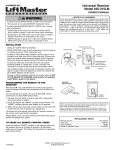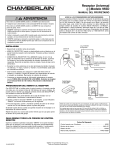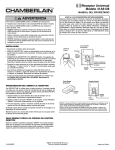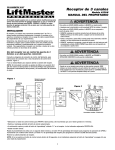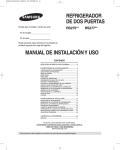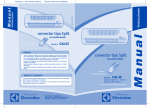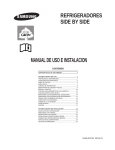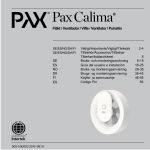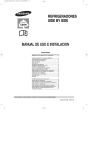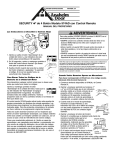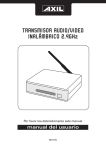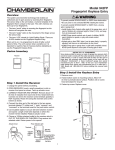Download Universal Radio Control OWNERS MANUAL Model 535
Transcript
Universal Radio Control OWNERS MANUAL WARNING Model 535-315LM SECURITY✚ Receiver Only WARNING To prevent possible SERIOUS INJURY or DEATH from electrocution: • Be sure power is not connected BEFORE installing the receiver. To prevent possible SERIOUS INJURY or DEATH from a moving gate or garage door: • ALWAYS keep remote controls out of reach of children. NEVER permit children to operate, or play with remote control transmitters. • Activate gate or door ONLY when it can be seen clearly, is properly adjusted, and there are no obstructions to door travel. • ALWAYS keep gate or garage door in sight until completely closed. NEVER permit anyone to cross path of moving gate or door. Push Button Common Radio Power Opener Terminals Mounting Receiver ® 1 • Unplug the opener before proceeding. • Fully extend antenna wire below bottom of case as shown. • The receiver can be mounted directly on the door opener with the clips provided. Figure 1. or • Attached to a ceiling/inside wall of the garage with connecting bell wire (not provided). Fasten the receiver to the ceiling or inside garage wall with dry wall screws provided. Figure 2. NOTE: Transformer Model 85 is required if your residential garage door opener is a LiftMaster, Chamberlain or Sears. Antenna Wire Fully Extended Radio Power Opener Terminals Installation Using Clips Loosen the three terminal screws on the receiver (labeled 1, 2 and 3) Figure 1. Insert one end of a mounting clip under each terminal. Do not retighten at this time. Loosen the three terminal screws on the opener used for push button controls and radio power. Leaving the push button bell wire in place, insert the other ends of the mounting clips under the opener terminal screws. NOTE: If the number sequence of opener terminals doesn't match the receiver, turn the receiver around (so back is facing out) and complete the connection. Retighten the terminal screws on opener and receiver. Reconnect power to the opener. The receiver push bar should light. If it does not, use Transformer Model 85. Push Button Common 3 2 1 ® 2 Antenna Wire Fully Extended Push Button Opener Terminals 3 2 3 Installation Using Bell Wire Attach one end of 3-strand bell wire (not provided) to receiver terminals 1, 2 and 3. Connect the other end to the three opener terminals used for push button controls and radio power. Use insulated staples to secure bell wire between receiver and opener. Figure 2. Reconnect power to the opener. The receiver push bar should light. If it does not, use Transformer Model 85. Installation With Transformer Model 85 With the transformer, use a 2-wire connection only. Attach wire to receiver terminals 1 and 2 and to the opener terminals used for push button control. Plug the transformer into receiver and 120 Volt outlet. Figure 3. 2 ® 3 1 1 Programming the Remote to the Receiver With SECURITY✚, the code between the remote control and the receiver changes with each use, accessing over 100 billion new codes. You can activate your opener with up to 8 SECURITY✚ remote controls, and one SECURITY✚ Keyless Entry. 1. Pry open the front panel of receiver case with a coin or a screwdriver. Re-connect power to opener. 2. Press and release the “learn” button on the receiver. The learn indicator light will glow steadily for 30 seconds. 3. Within 30 seconds, press and hold the button on the handheld remote that you wish to operate your garage door. The opener will now operate when the push button on either the receiver or the remote control transmitter is pressed. Repeat Steps 2 and 3 for each remote control that will be used to operate the garage door opener. 1 2 3 ¤ 1 Indicator Light C P2 M Learn Button To Erase all Remote Control Codes Option Jumper Press and hold the “learn” button on the receiver panel until the indicator light turns off (about 6 seconds). All transmitter codes are now erased. Then follow the steps above to reprogram each remote control. C P2 M 2 3 Set Output Duration (Commercial APPLICATIONS Only) WARNING CONSTANT OPERATION To prevent possible SERIOUS INJURY or DEATH, the use of CONSTANT OPERATION on residential openers is PROHIBITED. CAUTION Output Duration Terminals 114A2578D WARNING MOMENTARY OPERATION Jumper M For commercial applications, the receiver can be set for either constant or momentary closure on the output contacts. Use of constant closure is prohibited on residential garage door openers because it overrides the safety reversal devices. With the jumper in the “M” (Momentary) position, the contacts will close for 1/4 second regardless of the length of radio transmission. With the jumper in “C” (Constant) position, the contacts will stay closed as long as the radio continues transmitting. The receiver is factory set at M. SPECIFICATIONS Output Rating......................................5 Amps 28VAC or DC Max. Power ....................................................18V - 30V ~, 30mA, 60Hz 18 - 30V , 30mA RF Frequency....................................................................315MHz If the power is other than shown in specifications, Accessory Transformer Model 85 or 95 is required. Accessory Transmitters — Series 50, 60, 70, 80 and 900. WARNING Jumper M Output Duration Terminals NOTICE: To comply with FCC and or Industry Canada (IC) rules, adjustment or modifications of this receiver and/or transmitter are prohibited, except for changing the code setting or replacing the battery. THERE ARE NO OTHER USER SERVICEABLE PARTS. Tested to Comply with FCC Standards FOR HOME OR OFFICE USE. Operation is subject to the following two conditions: (1) this device may not cause harmful interference, and (2) this device must accept any interference received, including interference that may cause undesired operation. © 2006 The Chamberlain Group, Inc. All Rights Reserved CIA Universal Radio Control MANUAL DEL PROPIETARIO ADVERTENCIA Modelo 535-315LM SECURITY✚ Receptor Solamente ADVERTENCIA Para prevenir LESIONES GRAVES o MUERTE posible por electrocución: • Asegurase que la electricidad no está conectasa ANTES de instalar el receptor. Para evitar posibles LESIONES GRAVES o incluso la MUERTE con el movimiento del portón o la puerta de cochera. • Mantener SIEMPRE los controles remotos fuera del alcance de los niños. No permitir NUNCA que los niños operen, o jueguen con transmisores de control remoto. • Activar la entrada o puerta SÓLO cuando pueda verse claramente, esté bien ajustada, y no haya obstrucciones al recorrido de la puerta. • Mantener SIEMPRE la entrada o puerta del garaje a la vista hasta que esté completamente cerrada. NUNCA permitir que alguien cruce la trayectoria de una entrada o puerta móvil. PRECAUCIÓN Electricidad Botón de radio Terminales del Abridor Común ® 1 Montaje del Receptor • Desenchufar el abridor antes de proceder. • Extender completamente el cable de la antena por debajo de la casa según ilustrado. • El receptor puede montarse directamente en el abridor de la puerta con los broches provistos. Figura 1. O • Fijo a un cielorasoi/pared interior del garaje con cable de timbre conectado (no provisto). Fijar el receptor al cieloraso o pared interior del garaje con los tornillos para tabiques de yeso y catón provistos. Figura 2. NOTA: Se Requiere el Transformador Modelo 85 si el Abridor de Garaje Residencial es LiftMaster, Chamberlain o Sears. Cable de Antena Completamente Extendida Botón Electricidad de radio Terminales del Abridor Común 3 2 1 ® Instalacion Usando Broches Aflojar los tres tornillos terminales en el receptor (rotulados 1,2 y 3) Figura 1. Insertar un extremo de un broche de montaje debajo de cada terminal. No ajustar en este momento. Aflojar los tres tornillos terminales en el abridor usado para los controles de botones y electricidad para el radio. Dejando el cable de timbre a botón en su lugar, insertar los otros extremos en los broches de montaje bajo los tornillos terminales del abridor. NOTA: Si la secuencia numérica de los terminales del abridor no corresponde con el receptor, girar el receptor (de manera que la parte postterior mire hacia afuera) y completar la conexión. Volver a ajustar los anillos terminales en el abridor y receptor. Reconectar la electricidad al abridor. Debe iluminarse la barra del receptor. En caso contrario, usar el Transformador Modelo 85. Instalacion Usando Cable de Timbre Fijar un extremo del cable de timbre de 3 filamentos (no provisto) a los terminales 1, 2 y 3, del receptor. Conectar el otro extremo de los tres terminales del abridor usados para la electricidad de los controles del botón y del radio. Usar broches aislados para asegurar el cable del timbre entre el receptor y el abridor. Figura 2. Reconectar la electricidad al abridor. Debe iluminarse la barra del receptor. Si no, usar el transformador Modelo 85. Instalacion con el Transformador Modelo 85 Con el transformador, usar una conexión de 2 cables solamente. Fijar el cable a los terminales 1 y 2 del receptor usados para el control del botón. Enchufar el tranformador al receptor y el tomacorrientes de 120 voltios. Figura 3. 2 Cable de Antena Completamente Extendida Botón Terminales del Abridor 3 2 3 2 ® 3 1 1 Programacion del Remoto al Receptor Con SECURITY✚, el código entre el control remoto y el receptor cambia con cada uso, con acceso a más de 100 billiones de nuevos códigos. Se puede activar el abridor con hasta 8 controles remoto del SECURITY✚ y una entrada sin tecla de SECURITY✚. 1. Separar abierto en panel delantro de la caja del receptor con una moneda o un destornillador. Reconectar la electricidad al abridor. 2. Oprimir y soltar el botón “learn” en el receptor. La luz indicadora “learn” se ilumina continuamente por 30 segundos. 3. Para 30 segundos, oprimir y mantener oprimido el botón en el remoto manual con el cual sedesea operar la puerta del garaje. El abridor opera ahora cuando se oprime el botón en el receptor o el transmisor de control remoto. Repetir los pasos 2 y 3 para cada control remoto que se usa para operar el abridor de la puerta del garaje. 1 2 3 ¤ 1 Luz Indicadora C P2 M Botón "Aprendizaje" Puente Opcional Para Borrar Todos los Códigos de Control Remoto Oprimir y mantener oprimido el botón “learn” en el panel receptor hasta que se apague la luz indicadora (6 segundos aproximadamente). Todos los códigos del transmisor están ahora borrados. A continuación seguir los pasos de arriba para reprogramar cada control remoto. Graduacion de la Duracion de Salida 2 ADVERTENCIA OPERACIÓN MOMENTANEA ESPECIFICACIONES Clasificación nominal de salida . . . . . . . . . . 5 Amps 28VCA o CD, Máx. Potencia . . . . . . . . . . . . . . . . . . . . . . . . . . . . . 18V a 30V ~, 30mA, 60Hz , 30mA 18V a 30V Frecuencia . . . . . . . . . . . . . . . . . . . . . . . . . . . . . . . . . . . . . . . . . 315MHz Si la potencia es diferente a la indicada en las especificaciones, se requiere el transformador Modelo 85 o 95. Transmisores accesorios —Series 50, 60, 70, 80 y 900. Terminales de Duración de Salida M Para aplicaciones comerciales, el receptor puede graduarse para cierre constante o momentáneo en los contactos de salida. El uso de cierre constante está prohibido en los abridores de puertas de garajes resideniciales ya que cancela los mecanismos de inversión de seguridad. Con el puente en la posición “M” (Momentánea), los contactos se cierran por 1/4 de segundo sin importar la duración de la transmisión radial. Con el puente en la posición “C” (Constante), los contactos permanecen cerrados mientras la radio continúa transmitiendo. El receptor está graduado de fábrica a M. Puente ADVERTENCIA M El uso de OPERACION CONSTANTE en abridores residenciales está PROHIBIDO, para prevenir LESIONES GRAVES o MUERTE posibles. 114A2578D M Puente Terminales de Duración de Salida ADVERTENCIA P2 3 OPERACIÓN CONSTANTE (APLICACIONES Comerciales Solamente) C PRECAUCIÓN AVISO: Para cumplir con las reglas de la FCC y/o de Canadá (IC), las reglas, ajustes o modificaciones de este receptor y/o transmisor están prohibidos, excepto por el cambio de la graduación del código o el reemplazo de la pila. NO HAY OTRAS PIEZAS REPARABLES DEL USUARIO. Se ha probado para cumplir con las normas de la FCC para USO DEL HOGAR O DE LA OFICINA. La operación está sujeta a las dos condiciones siguientes:(1) este dispositivo no puede causar interferencia perjudicial, y (2) este dispositivo debe aceptar cualquier interferencia recibida, incluyendo la interferencia que puede causar una operación no deseable. © 2006 The Chamberlain Group, Inc. Todos los Derechos Reservados




